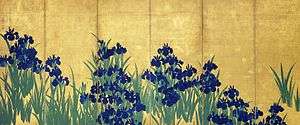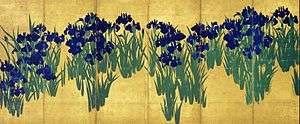Irises screen


Irises (紙本金地著色燕子花図 shihonkinji chakushoku kakitsubata-zu) is a pair of six-panel folding screens (byōbu) by the Japanese artist Ogata Kōrin of the Rinpa school. It depicts an abstracted view of water with drifts of Japanese irises (Iris laevigata). The work was made c. 1701–02, in the period of luxurious display in the Edo period known as Genroku bunka. The screens were held for over 200 years by the Nishi Honganji Buddhist temple in Kyoto. They are now held by the Nezu Museum, and they are a National Treasure of Japan.
A similar by slightly later pair of screens by Ogata Kōrin depicting irises is held by the Metropolitan Museum of Art in New York City. All four screens were exhibited together in Japan in 2012.
Both screens are inspired by an episode in The Tales of Ise (伊勢物語 Ise monogatari).
Irises
The screens are among the first works of Ogata Kōrin (尾形光琳) as a Hokkyō (法橋) (meaning "Bridge of the Dharma"), the third highest rank awarded to Buddhist artists . It depicts bunches of abstracted blue Japanese irises in bloom, and their green foliage, creating a rhythmically repeating but varying pattern across the panels. The similarities of some blooms indicate that a stencil was used. The work shows influence of Tawaraya Sōtatsu. It is typical of a new artistic school, Rin-pa (琳派), which takes its name from the last syllable of "Kōrin".
Kōrin adopts a very restrained palette, limited to the ultramarine blue of the flowers, the green of their foliage, and the gold background. The work was made with ink and colour, on paper, with squares of gold leaf applied around the painted areas to create shimmering reflective background reminiscent of water. The deep blue was made from powdered azurite (群青 (gunjo)).
Each six-panel screen measures 150.9 by 338.8 centimetres (59.4 in × 133.4 in). They screens were probably made for the Nijō family, and were presented to the Nishi Honganji Buddhist temple in Kyoto. They were sold by the temple in 1913.
Irises at Yatsuhashi
.jpg)
Kōrin made a similar work about 5 to 10 years later, another pair of six-panel screens, known as Irises at Yatsuhashi (Eight Bridges) (八橋図屏風). They have been held by the Metropolitan Museum of Art in New York City since 1953.
his second pair of iris screens, c.1710, was made in ink and colour, painted over a gold leaf background on paper. Each screen measures 163.7 by 352.4 centimetres (64.4 in × 138.7 in). Unlike the earlier pair of iris screens, this later pair includes a depiction of an angular bridge, a more explicit reference to the literary work that inspires both works.
The Tales of Ise
Both pairs of screens are inspired by an episode in The Tales of Ise (伊勢物語 Ise monogatari), where the unnamed protagonist of the story, probably the poet Ariwara no Narihira, encounters the flowers near a rustic eight-plank bridge over a river, and is inspired to compose a romantic poem, a form of acrostic where the first syllable of each line creates the Japanese work for iris (ka-ki-tsu-ha-(ba)-ta). The Japanese iris, Iris laevigata (Kakitsubata (カキツバタ)) grows in marshy wet land.
| Original text | Pronunciation | Meaning |
|---|---|---|
|
からごろも |
Karakoromo |
I have come so far away on this trip this time and think of my wife that I left in Kyoto |
Influence
The screens clearly influenced the Irises paintings by Vincent van Gogh: he could never have seen the originals, which were still in Japan, but they were reproduced as woodcuts in a collection, Korin Hyakuzu Kohen.
See also
References
- Irises, Nezu Museum
- 燕子花図 (kakitsubata-zu), Nezu Museum
- 八橋図屏風 Irises at Yatsuhashi (Eight Bridges), Metropolitan Museum of Art
- Designing Nature: The Rinpa Aesthetic in Japanese Art, John T. Carpenter, Metropolitan Museum of Art p.210
- Irises: Vincent Van Gogh in the Garden, Jennifer Helvey, p.118
- Twenty-Five Words for Iris: Ogata Korin at the Nezu Museum, Alan Gleason, artscape Japan
- Irises (kakitsubata) by Ogata Korn, Columbia University